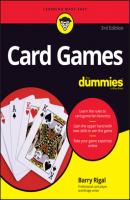Card Games For Dummies. Barry Rigal
Чтение книги онлайн.

Читать онлайн книгу Card Games For Dummies - Barry Rigal страница 14
Название: Card Games For Dummies
Автор: Barry Rigal
Издательство: John Wiley & Sons Limited
Жанр: Сделай Сам
isbn: 9781119880448
isbn:
When you move a complete row or column, you create a space or gap into which you can often move whatever card(s) you like.
Frequently, you don’t use all the cards in the initial layout; the remaining cards are called the stock. You go through the stock to advance the Solitaire.
When working through the stock, you frequently have cards that you can’t legally put into the layout. In such cases, the unused cards go into the waste pile.
Redeals take place in the middle of a Solitaire when you’ve exhausted all legal moves. The rules of the Solitaire may allow you to redeal by shuffling and redistributing the unused cards in an attempt to advance the game.
Many Solitaires permit one cheat — you can move an obstructing card or otherwise advance the game. This process is also known as a merci.
After you build your own foundation of Solitaire knowledge, you can begin to explore the many variations of the game. The following sections detail some of the specific types of Solitaires.
Putting the Squeeze on Accordion
The game Accordion is also known as Methuselah, Tower of Babel, or Idle Year (presumably because of the amount of time you need to keep playing the game to win it).
Accordion is a charmingly straightforward game that can easily seduce you into assuming that it must be easy to solve. Be warned — I’ve never completed a game of Accordion, and I don’t know anyone who has! This challenge, I can only assume, makes success at the game doubly pleasurable.
Accordion also takes up very little space — a major benefit because you tend to play Solitaire in a cramped space, such as a bus station or an airport lounge.
The objective of Accordion is to finish up with a single pile of 52 cards. Relative success is reducing the number of piles to four or fewer. Your chances of complete victory may be less than 1 in 1,000, based on my experiences, but don’t let that deter you from giving this game a try! The fact that it is a very fast game to play means that you can abandon unpromising hands and move on to another, without wasting much time.
Looking at the layout
The layout for Accordion is simple. Follow these steps to begin your long journey:
1 Shuffle the deck well, and then turn over the top card in your deck and put it to your left to start your layout.
2 Turn over the next card.If the card is either the same suit (both clubs, for example) or the same rank (both jacks) as the first card, put the second card on top of the first. If you don’t have a match, use the card to start a new pile.
3 Turn over the third card and compare it to the second card.Again, if the suits or ranks of the cards match, put the third card on top of the second card; if not, start a third pile with the third card. You can’t match the third card with the first card. However, when matching cards (of suit or rank) are three cards apart, you can combine them as if the cards were adjacent. In other words, you can build the fourth card on the first one.
4 Continue by going through every card in the deck in this way.I told you it was easy! The game ends after you turn over the last card. To win, you must assemble all the cards into one pile.
Your initial cards may look like one of the examples in Figure 2-1 after you lay out three cards.
FIGURE 2-1: At the start of Accordion, your cards may fall in this manner.
In the first example, you must create three different piles because the cards are unrelated in rank or suit. In the middle example, you can put the ♦4 on top of the ♦Q (because they share the same suit), leaving you with only two piles. In the bottom example, you can put the ♦7 on top of the ♦Q, which allows you to combine the two 7s, resulting in a single pile.
To see how you can combine cards placed three piles away from each other, look at Figure 2-2.
FIGURE 2-2: You can match cards that are three places away from each other to further your game progress.
After you turn up the ♣Q, you can place it on the ♦Q (because they’re three apart and match in rank) and then put the ♣K on the ♣Q (same suit). The ♥J then moves to the first row.
Choosing between moves
When moving the cards, you frequently have to be careful to make the plays in the correct order to set up more plays. You may have a choice of moves, but you may not be sure which move to execute first. Look at a possible scenario in Figure 2-3.
After you turn up the ♥4, you can place it on the ♥9, which opens up a series of moves that you can play. The best option is to move the ♥4 onto the ♠4 and then move the rest of the cards into their new spaces.
Because the ♠K is three cards away from the ♣K, you can combine the two cards and then move the ♥4 onto the ♥J. Now the ♦9 is three cards away from the ♦Q, so you can combine those two cards.
Figure 2-4 shows you how waiting can help you make up your mind when you have a choice.